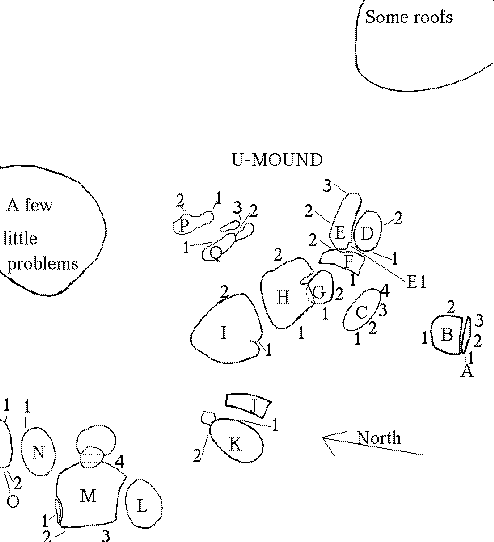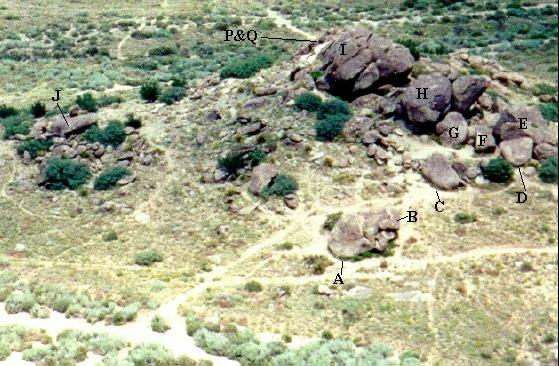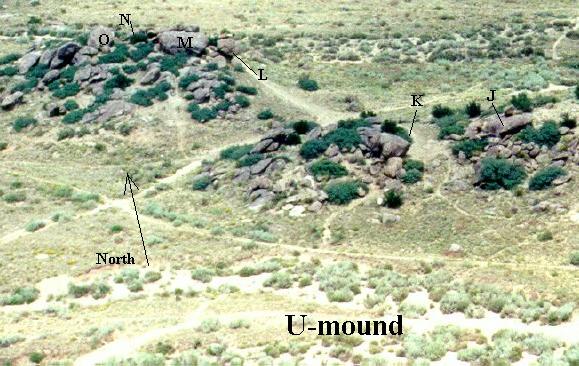A. Fin/blade shaped rock: Brett and Jill boulder.
The first one you come to on the way in.
Used to be called "Brett and Jill" boulder because of some now invisible
graffiti. There are three established routes on the front face: left, middle,
ad right. Left is the easiest; the crux is getting off the ground. Right is
next, although it is the most balancy of the three. Middle is technically
easier than right, but much more committing. I found a new (?) line between
the middle and right lines (2.5 below).
- ** 1. (left) The easiest way up is to climb the front side using the
edge. A better way is to climb on the face by the edge, but without using
the edge. The top has big jugs on the right -- and you can always grab the
edge if you feel uncomfortable. V0 with the edge, V1- without, but with a
V1+ move off the ground.
- ** 2. (middle) Hard start like the other two; tricky feet as you set up
on high holds, then you must commit to moving your feet over the buldge,
reaching for a very strong flake (you can sink 3-4 fingers behind it) to
make the next move. After that things are easier: better feet and positive
holds, ending with jugs at the top. Just V1+, but committing, so let's call
it V2-.
- ** 2.5. (middle-right) More committing than the middle line, because the
holds are mostly tiny sidepulls, forcing you to lieback your way over the
bulge. At V2, the most technical of the four lines on the front face.
- * 3. (right) An easier start than the other two, but funky once you're
off the ground. Use the right edge -- otherwise the difficulty goes up
seriously. Once you have the big black knob, use it with your right hand as
a sidepull and move straight up to reach the edge, then follow the edge up.
From the black knob on, you can always duck off to the right any time you
get uncomfortable. V1+.
- ** 1-3 traverse (low down -- just off the ground). Tricky in the middle,
where handholds are tiny and scarce and feet tend to slip. Easier to do
left-to-right than right-to-left. V1+?
Backside of the fin: a fun lieback exercise: go up the entire fin and
across the other side, then make the round trip -- coming back down
towards the west all the way to the ground is the hardest part.
V0+ (perhaps V1- for the last two moves coming down). Great warmup.
B. Behind the fin.
There is a large boulder with a north (back) side that overhangs a bit.
- 1. There are various knobs and cracks on the back side. A sit-start
under the big knob on the right yields a fairly interesting route. There
are lots of variations to be done back here, all very short.
Most are in the V1 range.
|
|
|
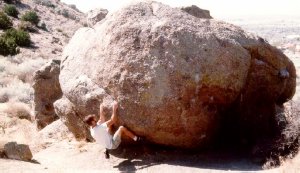 |
- * 3. On the East/Northeast corner, just left of the last crack on the
back, there's a sit-start off a detached flake. Hard off the ground and
harder (all pointed crimpers on the right, sloping dish and crimpers on the
left) higher up. Perhaps V3+ with standing start, V4- with sit-start. Tape
your fingers or be prepared for bleeding...
Yet farther east, there is an ill-defined problem moving diagonally up
on very painful holds.
C. Small slab uphill from the fin.
- * 1. Easy problem that goes by a big black knob/chunk. V0.
|
- * 2. The obvious crack near the center. It is usually done from a
standing start but a sit-start causes some of that pain we enjoy so much.
The sit is probably about V1+ish.
|
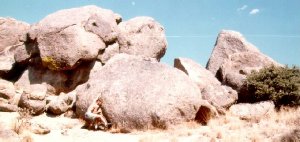 |
- 3. There's a little toe pocket at about knee height and a thin crack up
higher. This problem seems slightly harder than the standing start of line
C2.
D. One of the rare boulders with some fair-sized holds.
- 1. Sit start at a good two-hand knob. Throw to the good horizontal and try not to wallow while going over the top (the finishing hold is a dish
that often contains water...) A harder variation is to sit-start at the
south end and traverse the horizontal crack.
- 2. A sort of awkward standing start just to the right of a fair sized
knob. Thin feet and hands. The crux is grabbing the knob.
There's a hard problem on the north/northwest side that starts at a small
sidepull and also a route up the east/northeast arete.
E. Knob boulder
|
- ** 1. Knob problem A spotter is recommended for this one. It can either be
sit-started from the undercling, or starting from the knob. The sit comes
around the left and up to the knob, but is distinctly awkward -- big reach
and lots of rock to hit in the middle, so hard to do without scraping
something (like your chin!). From the knob, it's a throw up to a sidepull
near the top, reset the feet, and throw again to a smaller knob. Once the
feet are reset once more the top-out is easy. From the sit, V3-? Stand, V2+?
|
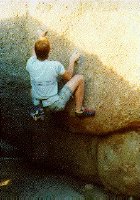 |
- ** 2. High problem, don't fall off. The crux (V2) is getting off the
ground. Follow the path of least resistance through the knobs and edges off
the ground (slightly to the right of the start position). The top feels like
5.7/5.8, but the landing zone is really bad, so don't fall. Downclimb 3
moves on the backside (perhaps 5.3).
- ** 2.5. I found a new (?) line on the north arÍte of that large
boulder; a beautiful, clean line, with a hard start right below a small
ledge with a bit of grass; start with a strong but low right sidepull and
a very high (you need to be at least 5'9" to have any chance) left crimper
(sharp!); move your feet to two good footholds and throw for the jug on
the ledge; mantle and finish up the easy top part of the arÍte;
V3-ish if you are over 5'9", at least V6 otherwise
- 3. Overhanging crack; nice short problem from a standing start (say
V1+); a sit-start is possible, but silly, because it is so much harder
(vanishing feet under the overhang; perhaps V4)
F. Tipped over Jelly Bean boulder
(flat face to the west)
- * 1. Hand traverse. Probably V1+ or 2.. go right to left. Crux is
reaching past the slopey bit just before the highest point and again the
part after it going back down.
- 2. Sit start between boulders E and F. There's not really anything for
the right foot at the start. Hard not to hit the boulder behind
you as you throw. Best for shorter climbers.
There's a no-hands problem between D and F.
G. A little dome just right of the nose shaped overhang.
- * 1. Start with your hands in the 2 pockets about 6 1/2 feet up...
Upper holds tend not to be as good as they look. Perhaps V2-.
|
- * 2. Start with your right foot on the arching crack. Easier than G1 if
done right, but very balancy; V1.
|
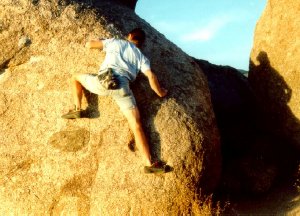 |
H. The Manatee
|
- * 1. The Manatee Undercling traverse.
Start on the left and work as far right as you like -- but be careful
of the landing on the far right. ~V0+ if you follow the fun crack all
the way to the top on the right; if you top out left after the traverse,
perhaps V1/V1+.
|
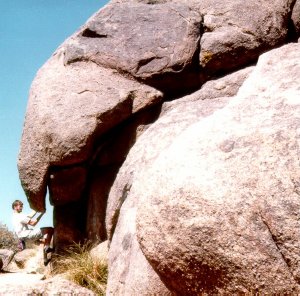 |
- ** 1.5 The Manatee direct The top has a pair of bolts
for the face problem above the undercling; nice powerful moves;
the crux is getting your feet up on that face.
Really high -- high enough you want several crash pads
and high confidence or, better, use a rope; feels like V3/V3+, but working
it without rope makes it feel a lot harder -- making the last moves on
the rounded top is somewhere between exhilarating and terrifying...
Last time I was there, some idiot had chopped the bolts.
- 1.75 On the right (east), overhanging side is some reconstructed "hueco"
quite high up after a sequence of very thin edges -- definitely a hardman
problem (no guess as to the rating); it too had one bolt, now chopped.
- * 2. On the back side there's a tricky crack that arcs up to
the left. (Balance is interesting -- you have to force your body in a
somewhat unnatural position to keep frictioning; top is easy.) Perhaps V1+?.
Can also be done from a sit-start in the crack.
I. The other big boulder.
- ***0.5 Just left of the chimney is a very cool problem with a crack
for the left hand and slippery sidepull rail for the right.
Not the best landing, but Andy survived a fall from the top (missing the
crash-pad of course). :) V5
- 1. A friend of Andy's did the hand jam roof crack just right of the wide
crack. His hands were bleeding by the time he was done...
- 1.5 A glued traverse thing that looks to be pretty hard
- * 2. An easy crack with many variations; the farther left (and thus the
later you rejoin the crack itself), the harder and more esthetic it gets;
from V0+ to V2-
- On the east side are two hard, seriously overhanging problems, both with
very bad landings -- back breakers, in fact; the right-hand one is easier,
perhaps V4+ (no feet!); the left-hand is much harder (no guess as to the
rating)
J. Slabs
Nothing too notable. Some of the easier rock at U-mound.
K. Andy's "Mom likes it" boulder.
|
- 1. Mom likes it
This would have stars if it wasn't so painful. Do a half sit-start on
the left, up to a knob, a blind reach up onto the top, using a little knob
for feet, traverse right, drop down onto the knobs, reach up to the next
boulder on the right (it's off for feet), and top out. V3+ or V4
|
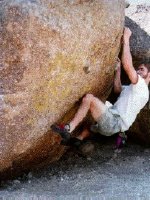 |
- * 2. On the backside there's an easy problem up the slanting crack, V0
with funky balance.
- * 3. Immediately left of K2 crank up from the horizontal to the knob,
set your feet, and slap for the top; powerful but easy, perhaps V1+
L. Balanced boulder with overhanging sides.
- ** 1. Sloper problem.. On the south side, start from an
undercling/sidepull and roll up to the sloper, match and work up to the
upper sidepull. I found the large crystals beside the sloper to be helpful.
V3-ish; foot placement is the key to the whole problem .
- 2. It looks like the whole east side could be traversed and topped out.
I've only done the last part up the left juggy hand traverse crack.
The middle section of the traverse looks pretty stout!
M. Large boulder with separated flake on the west side.
- * 1. Flake traverse. One of the easiest problems around, V0-; can be
linked with M2.
- 2. High step problem. The crack to the right of the flake. V2+ (very
powerful lieback on fingertips). A lot harder if you can't highstep
really high, because there is not much in the way of holds up
there.
- 2.5. A jump start to a good hold of white crystals high up on the smooth
face; the only hard part is sticking the hold on the jump (call it V2+), the
rest is a fairly easy mantel. Too short to be good, but unusual!
- * 3. The crack on the right can be about V2 or much harder if you forget
to use your feet on the upper part. Tricky start, especially if you are
short. Beware of the landing/bushes.
- 3.25. Farther right of M3, on the southeast corner. Nice crystal
climbing, but a bit short.
- * 3.5 On the east face, there's a problem that starts on a decent
hold and goes up to a right gaston, then on up. Hard.
- * 4. A sit start at the base of a big crack. The crack is easy, but use
good technique or you'll lose skin. Call it V0+.
Andy did a traverse starting at M3 and moving left. He went as far as the
quartz crystal, and then made a reach out left to a black angled chunk,
but couldn't get onto it to top out. It was V4ish to there.
N. Hollow Roof Boulder
Looking a bit like a mushroom from that side:
the top boulder is fairly thin and bulges out considerably from its eroded
support; the top surface is only about 7ft off the ground, but the bulge is
severe -- you end up nearly bent in two.
- ** 1. Hollow roof. The hollow part is below the roof. Sit-start and come
out on the left. Incredible foot hook; get the big black knob on the left,
throw to a good knob on the black part low on the right, move up your left
foot, and top out using the crack in the middle of the top. Say V2+ (you
need good flexibility and sufficient reach to get the good knob on the right
while holding the large black knob on the left; if you're shorter than 5'7",
call it V4-ish)
- * 2. Immediately right (as you face the boulder) of N1, the crack used
for top-out on N1 comes to the lip; move up along this crack and top out;
similar moves on topout, but the reach is reasonable here; perhaps V2-
O. Ouch.
Because of the holds, but could also be because of all the broken beer
bottles on the ground -- tread carefully!
- 1. Three hard moves on a steep face on pointy crimpers with bad feet.
V4 or so; the whole trick is to keep at least one foot on...
- ** 2. Sit start or standing start going up good holds; worse holds on
top, but the good footholds make topping out easy. Pleasant and solid V1+.
Also possible to do a two-handed dyno to the top.
P. Wounded Knee -- a boulder with good crimp edges;
V0- descent to the west
- * 1. On the eastern edge of the boulder, a funky layback move with high
feet gets you to a decent crimper way up left; set your feet and reach up
right (crux), then finish on easy ground. V3+?
|
- ***2. Follow the line of positive edges on the right. A classic
crimpfest; probably V3-. Perhaps the best boulder problem at U-Mound. From
the lower crimps, try dyno-ing directly for the top jug -- a great V4 dyno
problem.
|
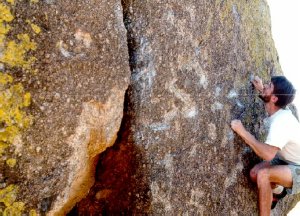 |
If you try the left line (immediately next to the crack),
you'll immediately notice a total lack of decent feet and much nastier
crimpers -- a much harder problem (V4-?)
- * 3. The crack between 1 and 2. Not the greatest of landings but
tolerable. Start the crack with a layback, then throw up left to a good knob
and start traversing right. Funky move shifting feet around. The top is
easier. Easiest way up that boulder, perhaps V2.
Q. High lichened wall.
- ** 1. Follow the lay-back crack. A spotter/crashpad is recommended
(there is an old bolt hole on top left, but the bolt itself is absent).
Don't lose fingers up there if you fall... Height-dependent; probably V2+
if you have a 6ft reach, but more like V3 otherwise.
|
- ** 1.5 Just to the left is a hard problem, first done by Todd Skinner
in 89. The second hold up and left is a sucker, go right slightly.
Crux is near the top and the landing is problematic -- use a crashpad for
sure and have a spotter to prevent you from landing too much left.
At least V4; and V5 if you start from the ground on the two heinous
crimpers. You can bring a Petzl short bolt and a hanger for the single
bolt on top if you want to toprope it. I am told this is a great problem,
hence the rating, but I have not done it.
|
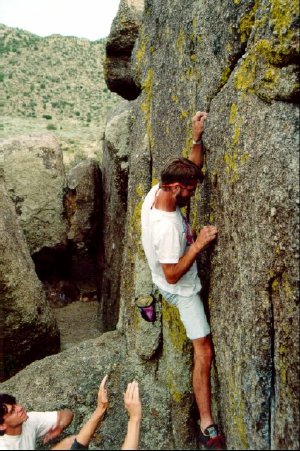 |
- 2. Several slab problems from V0 to V1?
- 3. A weird overhanging problem in-between the two boulders. Watch your
back.
- * 4. Hard painful slab problem about 15-20 feet left of the lay-back
crack. tiny crimpers (one-finger half-pad), and smears for feet... Just
three hard moves from the set up, yet I think it goes at V3 or more;
but someone accustomed to slabs appeared to walk up it and called it V1.
It's definitely harder than the P.1-2-3 (Wounded Knee) problems.
Other areas
On the next hillock northeast (150yds), there is one good boulder with a
steep northeast face covered in green lichen and slashed with an open book.
Climbing the open book is a fun V2- problem (the book slopes down gently, so
you have to counterweight your sidepull the whole time), with a reachy top-out
(but you can always bail out left into the open book). On the steep and
crystal-covered west face, I worked a harder, perhaps V3- problem; the crux is
surmounting the bulge, since there are no positive edges above it.
|
